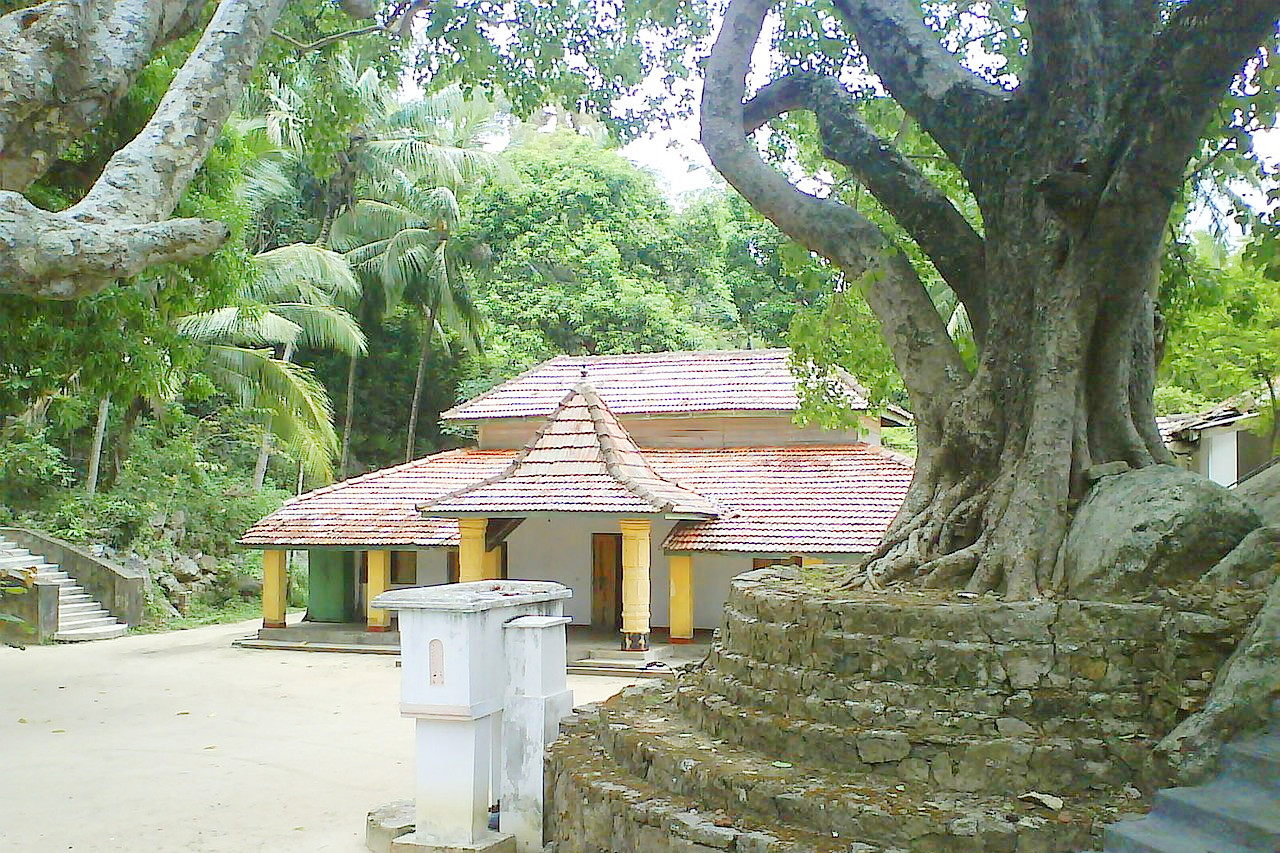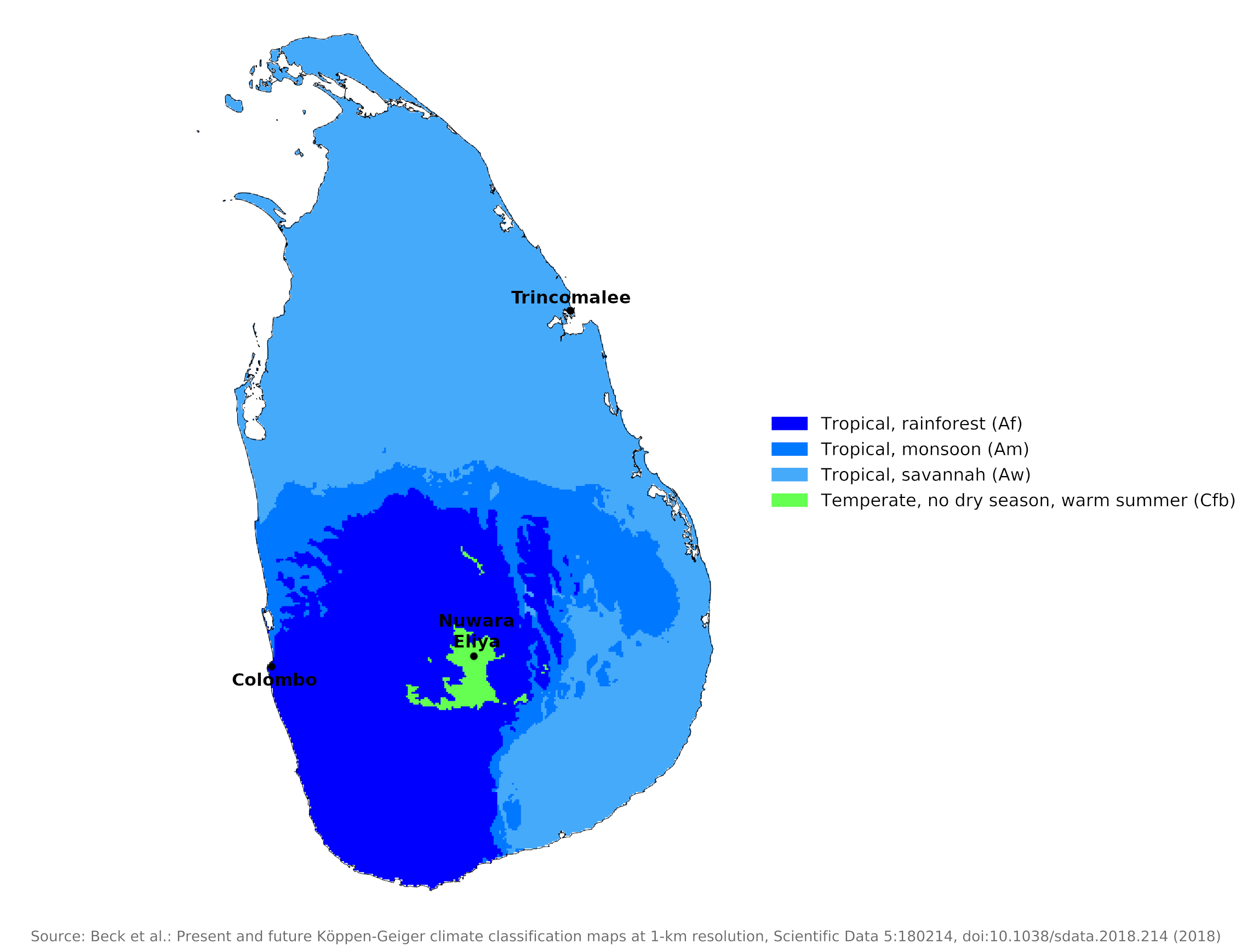The Climate of
Sri Lanka
 Ibbagala Buddhist Temple, Kurunegala
Ibbagala Buddhist Temple, Kurunegala
Climate Map
 Climate map of Sri Lanka
Climate map of Sri Lanka
What is the climate of Sri Lanka like?
Sri Lanka is a large island in the Indian Ocean just south of India. It consists of extensive lowland regions around the coast and a large mountainous interior where the highest peaks reach over 2,400 meters (8,000 feet). Located between 6° and 10°N, it has a typical tropical climate, modified somewhat by the seasonal wind reversals of the Asian monsoon.
The climate, although tropical and monsoonal, varies from warm in the coastal plains and lowlands to temperate in the hill and mountain regions. At lower levels, temperatures remain high year-round, and the high humidity and warm nights can feel uncomfortable for the unaccustomed visitor. On the coast, however, the heat is modified by the afternoon sea breeze, so it rarely becomes dangerous. In the interior highlands, temperatures are significantly lowered by the altitude, resulting in a pleasant climate most of the year; seldom too hot during the day and seldom so cool at night as to be uncomfortable; Frost is very rare here.
Anywhere on the island, the temperature remains fairly constant throughout the year. The temperature in Colombo varies only between 25°C and 28°C (77°F to 83°F). The island's lowland areas have hot weather, with average annual temperatures ranging from 23°C to 31°C (73°F to 88°F), while the central mountains are cooler, averaging 14°C to 24°C (57°F to 75°F).
The rainfall pattern is influenced by the Indian Ocean and Bay of Bengal monsoon winds and is characterized by four seasons. Beginning in May, the winds come from the southwest, bringing moisture from the Indian Ocean. When these winds hit the slopes of the central highlands, they unload heavy rains onto the mountain slopes and the southwestern sector of the island, but parts of the east and northeast receive little rain. The second season occurs in October and November, the inter-monsoon months. During this time of year, gusty winds occur regularly and tropical cyclones sometimes bring heavy rain to the eastern, northeastern and southwestern parts of the island. During the third season, December to March, monsoon winds come in from the northeast and bring moisture from the Bay of Bengal. The northeastern slopes of the mountains can be inundated with rain during these months. Another inter-monsoon season occurs in March and April, with light, variable winds and evening thunderstorms.
Daily sunshine hours vary between six and eight hours across much of the country, least during the rainiest seasons when cloudy weather can last two or three days. In many parts of the country it rains heavily in afternoon showers accompanied by thunderstorms. Humidity in Sri Lanka ranges between 70% and 90% on average. Humidity is typically higher in the southwest and mountainous areas and depends on the seasonal patterns of rainfall. At Colombo, for example, daytime humidity stays above 70 percent all year, rising to almost 90 percent during the monsoon season in June.
North and East
Seventy-five percent of Sri Lanka is an "arid" zone, mainly in the northern and eastern regions, but the term is relative. These areas receive an average annual rainfall of 1,250 to 1,900 millimeters (50 to 75 inches) with little rain between February and September. The main rainy season here is between October and January when the northeast monsoon blows onto the coast. Trincomalee is representative of the lowlands in the Northeast.
| Climate data for Trincomalee (1961–1990) | |||||||||||||
|---|---|---|---|---|---|---|---|---|---|---|---|---|---|
| Month | Jan | Feb | Mar | Apr | May | Jun | Jul | Aug | Sep | Oct | Nov | Dec | Year |
| Average high °C (°F) | 27.9 (82.2) | 29.2 (84.6) | 30.9 (87.6) | 33.0 (91.4) | 34.5 (94.1) | 34.7 (94.5) | 34.4 (93.9) | 34.2 (93.6) | 33.9 (93.0) | 31.8 (89.2) | 29.3 (84.7) | 28.1 (82.6) | 31.8 (89.2) |
| Daily mean °C (°F) | 26.1 (79.0) | 26.9 (80.4) | 28.0 (82.4) | 29.4 (84.9) | 30.5 (86.9) | 30.6 (87.1) | 30.1 (86.2) | 29.9 (85.8) | 29.6 (85.3) | 28.2 (82.8) | 26.7 (80.1) | 26.1 (79.0) | 28.5 (83.3) |
| Average low °C (°F) | 24.3 (75.7) | 24.5 (76.1) | 25.1 (77.2) | 25.8 (78.4) | 26.4 (79.5) | 26.4 (79.5) | 25.8 (78.4) | 25.5 (77.9) | 25.2 (77.4) | 24.6 (76.3) | 24.2 (75.6) | 24.2 (75.6) | 25.2 (77.4) |
| Average precipitation mm (inches) | 132 (5.2) | 100 (3.9) | 54 (2.1) | 50 (2.0) | 52 (2.0) | 26 (1.0) | 70 (2.8) | 89 (3.5) | 104 (4.1) | 217 (8.5) | 334 (13.1) | 341 (13.4) | 1,569 (61.8) |
| Source: NOAA | |||||||||||||
Southwest
The southwest coast and mountain slopes are the wettest regions, receiving 2,500 to 5,000 millimeters (100 to 200 inches) of rain each year. Here, precipitation is greatest in the periods April to June and September to November. This southwest monsoon brings some more rain to the southwest side of the island, but its arrival doesn't mark the same abrupt transition between a hot, dry season and a warm, wet season that occurs in much of the Indian subcontinent. Colombo is representative of the lowlands in the southwest.
| Climate data for Colombo (1961–1990) | |||||||||||||
|---|---|---|---|---|---|---|---|---|---|---|---|---|---|
| Month | Jan | Feb | Mar | Apr | May | Jun | Jul | Aug | Sep | Oct | Nov | Dec | Year |
| Average high °C (°F) | 31.0 (87.8) | 31.2 (88.2) | 31.7 (89.1) | 31.8 (89.2) | 31.1 (88.0) | 30.4 (86.7) | 30.0 (86.0) | 30.0 (86.0) | 30.2 (86.4) | 30.0 (86.0) | 30.2 (86.4) | 30.4 (86.7) | 30.7 (87.3) |
| Daily mean °C (°F) | 26.6 (79.9) | 26.9 (80.4) | 27.7 (81.9) | 28.2 (82.8) | 28.3 (82.9) | 27.9 (82.2) | 27.6 (81.7) | 27.6 (81.7) | 27.5 (81.5) | 27.0 (80.6) | 26.7 (80.1) | 26.6 (79.9) | 27.4 (81.3) |
| Average low °C (°F) | 22.3 (72.1) | 22.7 (72.9) | 23.7 (74.7) | 24.6 (76.3) | 25.5 (77.9) | 25.5 (77.9) | 25.1 (77.2) | 25.1 (77.2) | 24.8 (76.6) | 24.0 (75.2) | 23.2 (73.8) | 22.8 (73.0) | 24.1 (75.4) |
| Average precipitation mm (inches) | 58.2 (2.29) | 72.7 (2.86) | 128.0 (5.04) | 245.6 (9.67) | 392.4 (15.45) | 184.9 (7.28) | 121.9 (4.80) | 119.5 (4.70) | 245.4 (9.66) | 365.4 (14.39) | 414.4 (16.31) | 175.3 (6.90) | 2,523.7 (99.35) |
| Source: NOAA | |||||||||||||
Mountains
The climate of Nuwara Eliya reflects the cooler conditions in the higher parts of the interior. Here people will sometimes wear coats and sweaters in the coolest months.
| Climate data for Nuwara Eliya (1961–1990) | |||||||||||||
|---|---|---|---|---|---|---|---|---|---|---|---|---|---|
| Month | Jan | Feb | Mar | Apr | May | Jun | Jul | Aug | Sep | Oct | Nov | Dec | Year |
| Average high °C (°F) | 20.0 (68.0) | 21.2 (70.2) | 22.5 (72.5) | 22.8 (73.0) | 21.3 (70.3) | 18.9 (66.0) | 18.5 (65.3) | 18.7 (65.7) | 19.2 (66.6) | 19.8 (67.6) | 19.8 (67.6) | 19.4 (66.9) | 20.2 (68.4) |
| Daily mean °C (°F) | 14.7 (58.5) | 15.3 (59.5) | 16.3 (61.3) | 17.1 (62.8) | 17.1 (62.8) | 16.1 (61.0) | 15.7 (60.3) | 15.7 (60.3) | 15.7 (60.3) | 15.8 (60.4) | 15.6 (60.1) | 15.2 (59.4) | 15.9 (60.6) |
| Average low °C (°F) | 9.4 (48.9) | 9.4 (48.9) | 10.2 (50.4) | 11.4 (52.5) | 12.8 (55.0) | 13.3 (55.9) | 12.8 (55.0) | 12.7 (54.9) | 12.3 (54.1) | 11.9 (53.4) | 11.5 (52.7) | 11.0 (51.8) | 11.6 (52.9) |
| Average precipitation mm (inches) | 100.6 (3.96) | 77.7 (3.06) | 71.5 (2.81) | 158.4 (6.24) | 175.9 (6.93) | 171.9 (6.77) | 164.9 (6.49) | 161.0 (6.34) | 178.8 (7.04) | 226.8 (8.93) | 221.7 (8.73) | 196.0 (7.72) | 1,905.2 (75.02) |
| Source: World Meteorological Organization | |||||||||||||
References
- E. A. Pearce, Charles Gordon Smith, (1990) The Hutchinson World Weather Guide, John Murray Press. ISBN 1859863426
- Timothy L. Gall, (ed.), (2003), Worldmark Encyclopedia of the Nations, Eleventh Edition, Thomson Gale
- Federal Research Division, Library of Congress, (1990), Sri Lanka: a country study. Claitor's Pub. Division.
- Hugh Chisholm, (ed.), (1911), Encyclopædia Britannica, Eleventh edition, Cambridge University Press
The Climate of
Sri Lanka

In summary:
The climate of Sri Lanka is tropical and monsoonal. It varies from warm in the coastal plains and lowlands to temperate in the hill and mountain regions. Located only 879 km (546 mi) north of the equator, Sri Lanka has neither summer nor winter but only rainy and dry seasons. Average temperature in Colombo is 27°C (80°F).
The lowlands in the northeast receive an average rainfall of about 1300 mm (50 in), and the hill country in the southwest has an average of 2500 to 5000 mm (100 to 200 in), most of the rain coming during the monsoon season. Elsewhere, average rainfall varies from 630 mm (25 in) to 1900 mm (75 in).